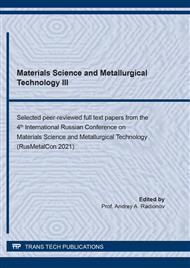[1]
W. Betteridge, Nickel and its Alloys, New York, (1984).
Google Scholar
[2]
J. Čubrová, K. Mertová, M. Duchek, Effects of rotary swaging, wire drawing and their combination on the resulting properties of Nickel-alloy wires, Materials and Technology. 54(5) (2020) 601-606.
DOI: 10.17222/mit.2019.177
Google Scholar
[3]
R.K. Burla, L. Chen, C.A. Zorman and M. Mehregany, Development of Nickel wire bonding for high-temperature packaging of SiC devices, IEEE Transactions on Advanced Packaging. 32(2) (2009) 564-574.
DOI: 10.1109/tadvp.2009.2015593
Google Scholar
[4]
T. Stuth, R. Theile, O. Krivtsova, New technological approach in fabrication of high purity Nickel wire, Materials Science Forum. 892 (2017) 59-63.
DOI: 10.4028/www.scientific.net/msf.892.59
Google Scholar
[5]
L.M. Zheleznyak, A.V. Eremin, Features of the production of semi-solid nickel wire, Rolled Metal Production. (12) (2016) 33-36.
Google Scholar
[6]
M. Kazeminezhad, Modeling the effect of redundant strain factor on the microstructure inhomogeneity of drawn and annealed wire, Journal of Computer-Aided Materials Design. 14(3) (2007) 435-446.
DOI: 10.1007/s10820-007-9060-2
Google Scholar
[7]
D.J. Celentano, M.A. Palacios, E.L. Rojas, M.A. Cruchaga, A.A. Artigas & A.E. Monsalve, Simulation and experimental validation of multiple-step wire drawing processes, Finite Elements in Analysis and Design. 45(3) (2009) 163-180.
DOI: 10.1016/j.finel.2008.09.001
Google Scholar
[8]
T. Schenk, T. Seifert, and H. Brehm, A simple analogous model for the determination of cyclic plasticity parameters of thin wires to model wire drawing, ASME. J. Eng. Mater. Technol. 129(3) (2007) 488-495.
DOI: 10.1115/1.2744436
Google Scholar
[9]
L.V. Radionova, R.A. Lisovsky, V.D. Lezin, Theory of energy conservation as the basis for the design of wire drawing, in: A.A. Radionov, V.R. Gasiyarov (Eds.), Proceedings of the 6th International Conference on Industrial Engineering (ICIE 2020). ICIE 2021. Lecture Notes in Mechanical Engineering, Springer, Cham., pp.1150-1163.
DOI: 10.1007/978-3-030-54817-9_134
Google Scholar
[10]
L.V. Radionova, V.V. Shirokov, S.R. Faizov, M.A. Zhludov, Studies of influence of process parameters on the strain rate at high-speed wire drawing, Materials Science Forum. 946 (2019) 832-838.
DOI: 10.4028/www.scientific.net/msf.946.832
Google Scholar
[11]
L.V. Radionova, R.A. Lisovskiy, A.V. Bryk, V.D. Lezin, Energetical theory of metal processing as the basis of the calculating resource-saving sequences method of wire-drawing, Bulletin of the South Ural State University. Ser. Metallurgy. 20(1) (2020) 68-79.
Google Scholar
[12]
G.N. Guryanov, Influence of metal hardening on the calculated values of the drawing stress, Zavodskaya Laboratoriya. Diagnostika Materialov. 5(77) (2011) 59-62.
Google Scholar
[13]
G.L. Baranov, Strain hardening in multipass drawing of a round nonhollow profile, Steel Transl. 48 (2018) 606-609.
DOI: 10.3103/s0967091218090048
Google Scholar
[14]
L.V. Radionova, S.R. Faizov, R.A. Lisovskiy, T.A. Lisovskaya, Automated laboratory drawing mill, Russian Internet Journal of Industrial Engineering. 5(2) (2017) 68-73.
Google Scholar
[16]
G.L. Baranov, The influence of the hardening curve profile on the drawing force of a bar, Solid State Phenomena. 284 (2018) 690-695.
DOI: 10.4028/www.scientific.net/ssp.284.690
Google Scholar
[17]
M.V. Erpalov, D. Nukhov, The influence of hardening curve on the shape and size of the neck of specimen in tensile test, Materials Science Forum. 989 (2020) 372-377.
DOI: 10.4028/www.scientific.net/msf.989.372
Google Scholar
[18]
S. Shetty, L. Nilsson, An evaluation of simple techniques to model the variation in strain hardening behavior of steel, Struct. Multidisc. Optim. 55 (2017) 945-957.
DOI: 10.1007/s00158-016-1547-6
Google Scholar


